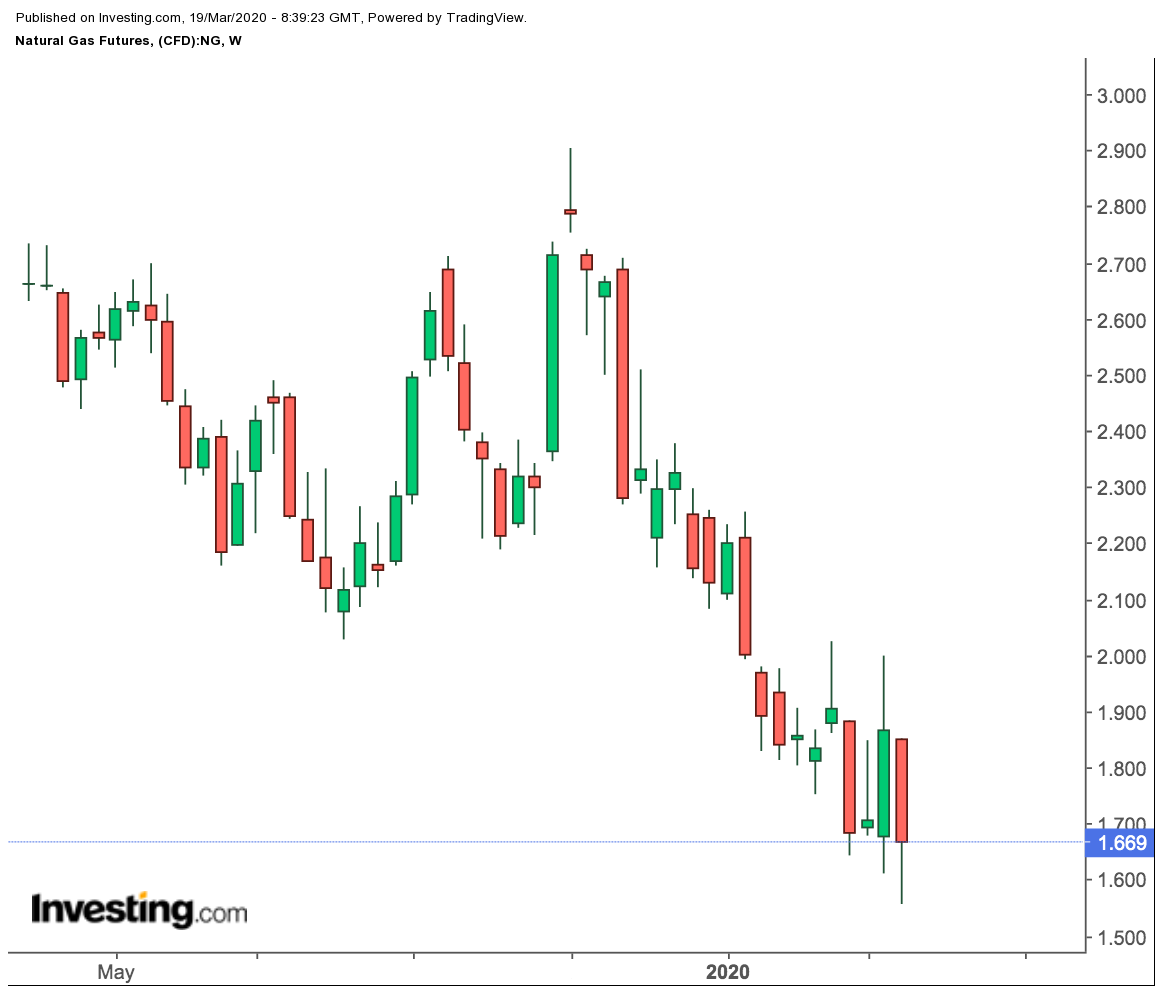For some longs in natural gas still shuddering at finding themselves at 25-year lows after this week’s 14% price collapse, I hate to be the bearer of this news: the worst isn’t over.
The coronavirus pandemic and its systemic destruction of the oil market and Wall Street has found another victim — natural gas.
Last week’s consumption of gas likely fell by 88% from the week prior as more Americans began working from home and fewer businesses operated full hours, reducing the need for heating in buildings and other commercial locations. 
The U.S. Energy Information Administration’s weekly gas storage report, due at 10:30 AM ET (15:30) today, is expected to show that U.S. utilities pulled just 6.0 billion cubic feet from storage for the week ended March 13, to burn for heating. The previous week’s drawdown was 48 bcf.
Last week’s gas consumption was even lower when compared to year-ago and seasonal levels. During the same week in 2019, gas storage fell by 91 bcf. The five-year (2015-2019) average for draws was more modest but still higher at 63 bcf.
Spring Brings Gloom For Gas, Not Hope
And with spring officially kicking off from today, there’ll be even milder temperatures, after what has already been a disastrous winter for gas bulls. Add to that the full or partial lockdown of New York, San Francisco and most major U.S. cities from the pandemic and you have a perfect storm for demand and gas prices.
For this week, estimates show draws not to be very different from last week, probably hitting around 9 bcf or so because of a slightly colder start to the week.
That’s not all. Analysts are now anticipating that there’ll only be two more weeks of gas withdrawals, after which the pre-summer injection season into storage will begin.
Typically, the so-called shoulder season between spring and summer is a tepid period for gas consumption and longs in the market are usually happy to wait for the arrival of hotter weather and demand for air-conditioning.
But this year’s summer outlook for gas might be even worse than we had for winter. If work-from-home and social distancing remains the new normal by June and beyond, then commercial demand for cooling will almost be decimated.
More Storage Builds Likely
Already at the current level, gas in storage stands at around 2.0 trillion cubic feet — about 16% higher than the five-year average and 76% above where it stood a year ago. Aside from unseasonable warmth through many phases of the 2019/20 winter, one reason for the outsize storage build is record high production of gas since the start of this year.
Given the current situation, gas longs should be afraid, very afraid of any more swellings in the inventory.
“The natural gas market’s capitulation has reached a new stage,” said Dan Myers, analyst at Houston-based consultancy Gelber & Associates. Said Myers:
“Ongoing developments will eventually help prices set a new floor that could stand for many years.”
In Wednesday’s session, the front-month gas contract on the New York Mercantile Exchange’s Henry Hub fell to as low as $1.56 per million metric British thermal units — marking a bottom since August 1995, when it traded at $1.39 per mmBtu.
There are various $1 level pricings in 1995 and 1994, meaning the next milestone for the market’s low might not be that great.
Scott Shelton, energy futures broker at ICAP in Durham, North Carolina, agrees with Myers that the current selloff in gas is virtually unprecedented in recent history.
But he also says bids at the low level could come in to create volatility, amid spreads play on the difference between spring and summer pricing of gas.
“Until we get some clarity on the demand side (which isn’t that bad), the path of least resistance is lower for spreads,” Shelton wrote in a market commentary on Wednesday. He added:
“And front-end flat price and volatility should continue to rise as there is no concept here of what spreads are actually worth.”
Some Reprieve If A Few Energy Drillers Go Bust
There could be a silver lining for gas too from the pandemic and the demand destruction it has wrought.
Some of the most debt-laden energy drillers in U.S. shale fields are likely to go bust in coming months from the impact of $20 oil versus production costs. Gas is often a by-product of oil drilling in the shale patches and if these companies go down, a chunk of the record high in gas production now could be wiped out.
Drillers like Chesapeake Energy (NYSE:CHK) and Whiting Petroleum (NYSE:WLL) were already facing financial difficulties before this month’s near 50% drop in U.S. crude prices resulting from the pandemic and ill-timed output hikes by oil producing titan Saudi Arabia.
Pioneer Natural Resources (NYSE:PXD), one of the leading producers in the Permian Basin of Texas and New Mexico, is running a series of models to decide its next steps and is likely to plan for a worst-case scenario, where oil prices might remain low for two years.
West Texas drillers Diamondback Energy (NASDAQ:FANG) and Parsley Energy (NYSE:PE) pledged on Monday to curb activity in response to the oil price decline.
“Probably 50% of the public E&Ps will go bankrupt over the next two years,” Pioneer’s CEO Scott Sheffield told the Wall Street Journal in an interview on Monday.
